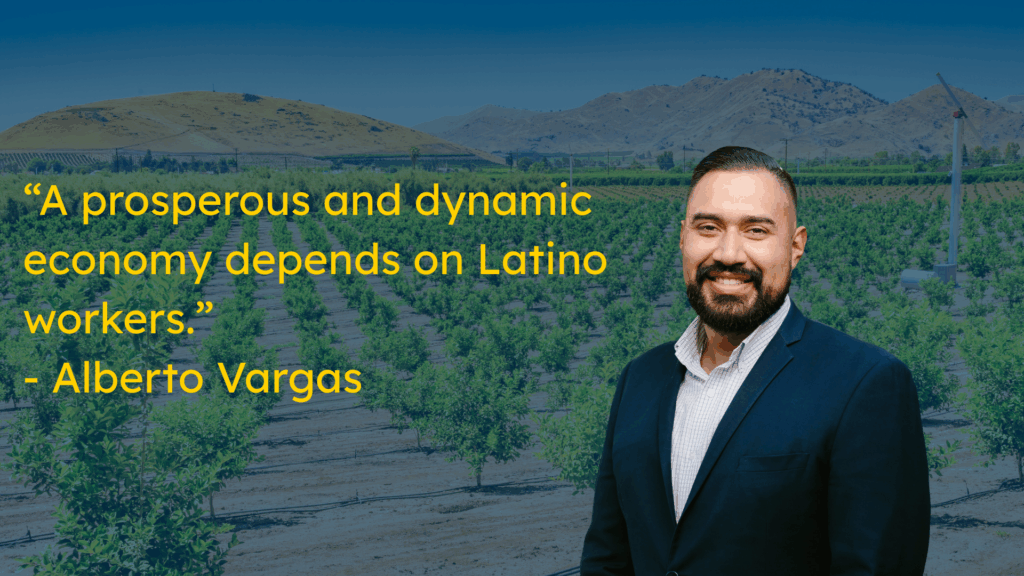Charlita: Alberto Vargas Shares Reflections on Latino Workers in California

The Latino workforce is central to California’s economy, yet faces steep disparities in wages, job security, health coverage, and housing. To better understand these findings, we asked Alberto Vargas, a graduate fellow and co-author of LPPI’s workforce briefs, to share his reflections. In this conversation, Vargas highlights the growth of Latino workers across regions, the barriers they encounter, and the urgent need for policies that reflect their essential role.
Q: What findings were consistent across all five regions, and why do you think that is?
Alberto: One of the most consistent findings across all five regions is that the Latino workforce has grown by at least 50% and in some regions, it’s more than doubled. This clearly indicates that Latinos make significant contributions to California’s economy and are a significant part of the labor force.
Another consistent finding is that in all five regions, at least one-fifth of Latino workers are noncitizens. This shows that noncitizen workers are essential to regional and state labor forces.
Q: Which findings resonated with you most?
Alberto: The number of uninsured Latino workers across all the regions, and specifically, the number of those without U.S. citizenship. For example, I live in Los Angeles County, where 37% of noncitizen Latino workers are uninsured. This is seven percentage points higher than for all noncitizen workers and 27 percentage points higher than for U.S.-born Latino workers in the county.
Despite many immigrants paying taxes, they cannot access state-sponsored health care. In the present day, we are seeing budget cuts impacting immigrant health care, and in California, the governor has proposed cuts to MediCal coverage for undocumented immigrants, while Congress has made severe cuts to federal Medicaid. These cuts will make it more difficult for Latino workers who are immigrants or support mixed-status families to stay healthy and provide for themselves and their families.
Q: Were there any findings you anticipated? If so, what were they?
Alberto: I anticipated that Latino workers would have some equity in their homes, but still fall below the state median. This tracks with my own experience: Latino homeowners—if they own their home—have owned it for some time or, if they have bought a home recently, are in the most affordable price range and neighborhood possible.
Q: Why is it important to highlight the Latino workforce at this moment?
Alberto: Latinos, whether they have legal status or not, are being ripped from their families at their homes, jobs, and places of worship through unjust raids. Yet time and time again, data show how essential Latinos are to our economy and society. The COVID-19 pandemic showed that Latino workers are essential workers. They are in the fields harvesting food for our tables, in the kitchen preparing our meals, on construction sites building our homes, and in care roles supporting children and the elderly. It is essential to acknowledge the significant contributions of Latinos to society and the economy, particularly as they drive population and labor force growth in each region. A prosperous and dynamic economy depends on Latino workers.
Q: Which industries or regions in California should policymakers prioritize for intervention?
Alberto: Policymakers should take steps to address job automation and lessen its impact on workers, particularly since our briefs showed that Latino workers are disproportionately impacted. Policymakers need to work with industry to provide opportunities for Latino workers to upskill or transition them into career paths and roles with greater job security. While technology can help some industries increase profit margins, automation’s impact on Latino workers—and the overall state workforce—will be felt in the short- and long-term. Since Latinos are overrepresented in high-risk jobs such as agricultural and warehouse workers, policymakers must establish guardrails to support them.
Q: Are there regions where Latino workers appear to be faring better than others?
Alberto: Latinos in the Inland Empire are faring better compared to those in the other four regions. For example, wages for Latino workers in the Inland Empire are similar to those in Los Angeles County, but living costs are lower. Housing is generally more affordable, giving more Latinos the opportunity to build wealth through homeownership. And while fewer Latino workers in the region have completed a four-year college degree, the area still offers college-educated Latinos career opportunities in higher-paying industries like public administration, information technology, finance, insurance, and real estate.
Q: What would you explore further if you had more time?
Alberto: I would explore the economic impact of Latino workers without citizenship in each region. For example: their tax contributions to local economies, the number of jobs they have created through business ownership, their access to homeownership, and the share of their earnings sent back to their home countries.
Q: How did these findings affect your perspective on work and opportunity in California?
Alberto: Our data shows that even before the ICE raids in California, Latinos faced challenges accessing stable and well-paying jobs. The recent raids will only deepen these challenges, making it harder for Latino workers to provide for their families. Some are now afraid to go to work—street vendors, for example, may hesitate to set up shop for fear of being questioned or detained because of suspicions of their status. Employers in agriculture and construction, two industries that are overrepresented by Latino workers, are also struggling to fill vacancies as a result of these enforcement actions. The repercussions that this will have on California’s and the nation’s economy will be significant.








